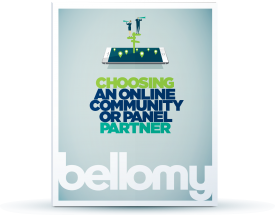How online research communities can facilitate customer segmentation
What do fingerprints, snowflakes, Social Security numbers and your customers have in common? No two are the same. Marketing strategies that target your entire customer base may be effective from time-to-time, but they are certainly not ideal. Conversely, it is impossible for a business with hundreds of thousands of customers to properly market to each individual. So, where’s the sweet spot?
How do we reconcile customized marketing strategies with a large customer base? Customer segmentation.
What is customer segmentation?
Customer segmentation is the division of a customer base into groups of individuals that share characteristics relevant to marketing and product/service development strategies (i.e., gender, age, income, etc.). Segmentation strategies also consider attitudinal attributes, like brand perception or political beliefs. These divisions allow marketers to more effectively manage the strategies they use to approach their customers. Each segment can be addressed with the most apt messaging and be advertised the products and services that are most relevant to them. Don’t waste money advertising a Louisville Slugger to LeBron James. Know your customers.
Why should you conduct a customer segmentation?
Segmentation shortens the research timeline. When you have pre-defined customer groups, there’s no need for extensive screening or preliminary activities to help you understand your customers — you already understand them. Online research communities that deliver quick insights are particularly important in modern consumerism, where change is the only constant. By the time you execute a traditional research strategy and arrive at the desired insights, your customers’ opinions and preferences have changed, and your findings are at risk of losing relevance. Segmentation helps mitigate this risk.
How can research communities inform a segmentation?
At a high level, online research communities are groups of people who participate in surveys, discussions and a host of other digital activities. Research activities and recruitments can be targeted at the entire community, or a subset — this is where segments are important.
But before you can conduct a proper segmentation, you need to be sure that you are asking the right questions so that your customers will be differentiated in meaningful and relevant ways. “How do you feel about pastels?” may be a relevant question for a crayon company targeting customers’ preferred palettes, but it's certainly not relevant for a utility supplier attempting to produce segments of its customers. Jokes aside, even if the questions are industry-specific, they could still be missing the mark.
This may seem obvious, but how do we determine which beliefs/attitudes/demographics actually matter, without guessing or using attributes that “seem right”?
First, we need to understand what we’re looking for. At this point, we’re not aiming to assess averages and consensus among members. Instead, we’re looking for topics.
- What are consumers talking about?
- What matters most (and least) to them?
- What are the factors of the purchase decision?
This is meant to be an exploratory phase, and should seek out fundamental attitudes, rather than granular details. Questions like, “What are the most important factors when choosing a hospital for specialized treatment, and why?” are specific enough to encourage informed, articulate answers, but general enough to leave room for unique responses. Trends in responses, especially disparate trends, may indicate meaningful factors.
How are meaningful user segments created?
The next step is to use that information to craft a survey that will define your consumers, and capture any relevant data based on the exploratory phase. At this point, it’s best to review the questionnaire and make sure that the data being collected will produce meaningful outcomes (at Bellomy, that’s our Marketing Sciences team a.k.a. the big guns). In order to conduct the actual segmentation, the sample must be larger than that of the qualitative exercises, and would likely use an entirely different sample source.
Once the survey has been distributed to a large, representative customer base, the data that has been collected along with other key operational data is analyzed using robust clustering algorithms. The key to success is ensuring that the analysis is conducted in a way that will produce actionable and reproducible solutions. These analyses are technical, advanced, and able to quantifiably differentiate consumers in a meaningful way with great confidence… but that's a topic for another article.
How can research communities activate a segmentation?
Want to know what Segment A (young, health-conscious racial minorities) think about your product without diluting the data with non-relevant customers? Only launch the survey to your pre-defined target audience, which may actually include a combination of segments. This eliminates the need to discover the appropriate audience each time you want to conduct research. Panel platforms typically allow for portions of the site to only be accessible by a subset of people. This way, you can conduct research with confidence, knowing that the right people are being asked the right questions without being influenced by non-relevant topics.
Research communities also help you conduct inter-segment analysis.
- How does Segment A feel about a product, compared to Segment B?
- Are the differences substantial enough to perhaps warrant a spin-off product?
- What about messaging – does Segment A want to be communicated with differently than Segment B?
Discussion posts and survey responses can be also evaluated by segment, showing you the differences between defined sections of your customer base. The difference in trends among multiple segments can be even more important than traditional, simple variables like age and gender.
Why should customer segmentation matter to you?
Customer segmentation can help you develop large-scale playbooks for marketing to and communicating with each segment in the ways that are most relevant, impactful, and actionable.
Successful segmentation that results in real business impact requires robust inputs and activation through thorough listening and profiling. Bellomy has over 10 years of experience recruiting, managing, segmenting, and engaging online research communities for a variety of industries. Contact a Bellomy market research expert to see what insights you can gain using a proprietary online panel or community.




